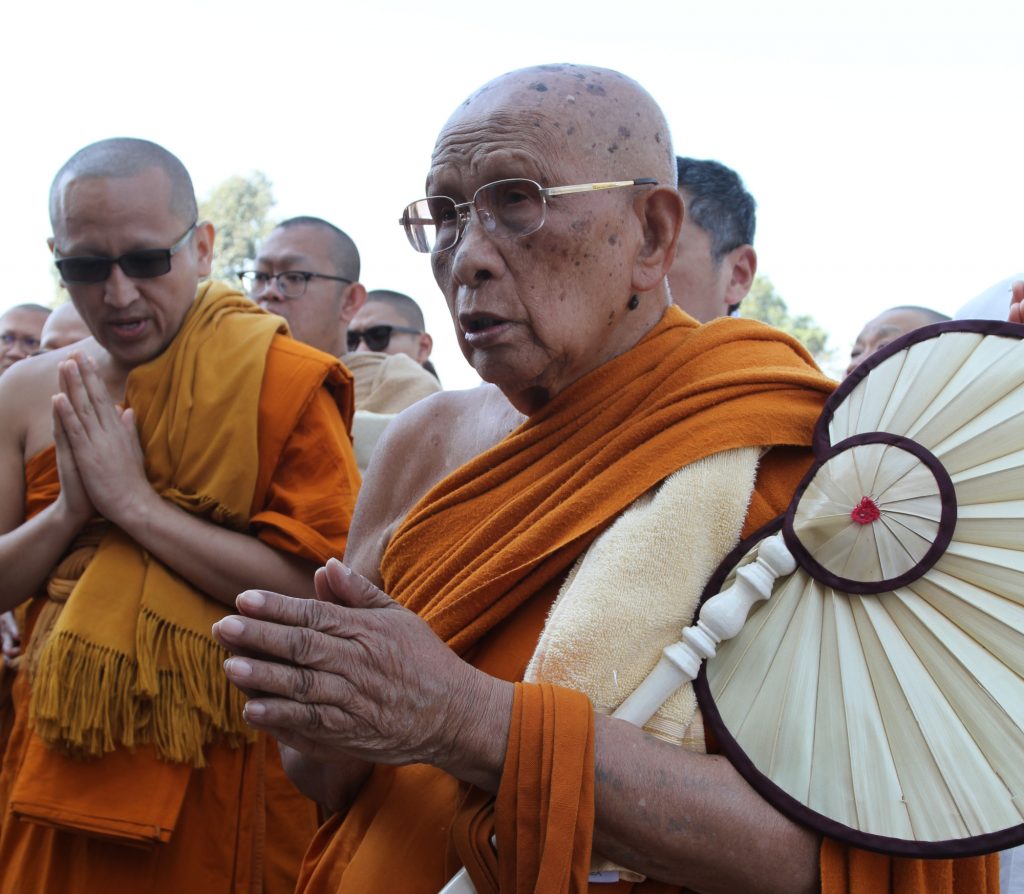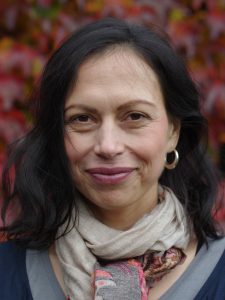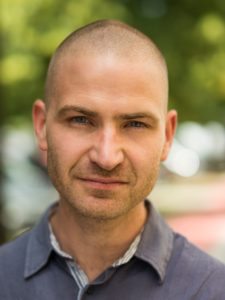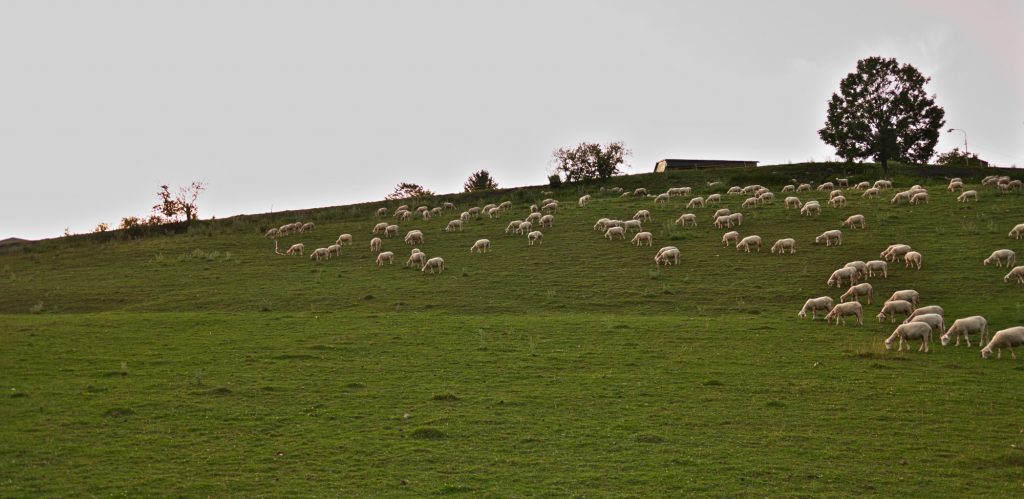This interview was published in the Zenshin magazine 3/2018. Here is its unabridged English version with slight corrections.
We invited teachers of Vipassanā meditation under the Vipassana.sk project, Katarína Bírešová and Václav Šmilauer for an interview. We talked about Vipassana meditation and much more.
Hi guys, what would you tell us about Vipassana that you practise
Vipassanā is a type of buddhist meditation (mind exercise) taught by the Buddha. There are many styles or lineages of Vipassana, just like many styles of dance. Our lineage stems from Ajahn Tong (95), one of the most respected Vipassana teachers in Thailand and southeast Asia. He studied with important Vipassana figures like Mahasi Saydaw from Burma but, that would be a long story so, maybe next time. Ajahn Tong is an abbot of the monastery in Chom Tong (a town near Ching Mai). There is an international center by the monastery, which he funded together with his wife Kathryn and has been tirelessly led by Thanat Chindaporn (77), our principal teacher.
 Most of our readers are familiar with some type of meditation. What makes Vipassanā specific?
Most of our readers are familiar with some type of meditation. What makes Vipassanā specific?
Let me start from a broader scope. In Theravada Buddhism, of which Vipassana is a part of, there is a sikkhā): personal integrity (sīla), concentration (samadhi) and wisdom (pañña). Vipassanā is a tool from the last box. It is about developing insight / wisdom / understanding. Vipassanā, literally translated, means to see distinctly (vi- relates to indo-european dv-, tw-, clearly recognisable in European languages: due, dva, two, …), see things “as they are”, but not any things, like what’s the weather in Australia, but…
I am sorry, but could you simplify it?
To realise that I am sitting when I am sitting; that I am thinking when I am thinking; that I am sad when I am sad; that I am calm when I am calm.
And if I am not calm?
Notice that you are not calm. In Therevada, two kinds of meditations are distinguished: samatha, various exercises to put mind into some pre-defined state: tranquility, compassion, gratitude, consciousness of infinite space etc, depending on the exercise. And then there is vipassanā, exercises aimed to “only” observe the mind, without manipulating it; to develop mindfulness (sati), awareness of what is happening, without dwelling in it. We always return to the awareness of what is happening.
How is Vipassana related to the Buddha and Buddhism?
Vipassana is, according to tradition, the exercise discovered, trained and taught by the Buddha. In a recorded speech Satipatṭhāna sutta it is written: “This is the only way, O bhikkhus, for the purification of beings, for the overcoming of sorrow and lamentation, for the destruction of suffering and grief, for reaching the right path, for the attainment of Nibbana, namely, the Four Arousings of Mindfulness.” 1 That refers to mindfulness directed to 4 areas of direct experience: body, feelings, activities of the mind, objects of the mind. To what extent today’s different styles of vipassans are the same as those practiced by the Buddha and his monks, it is more a question for buddhologists.
In November 2018, you will lead a 2.5-week retreat in Slovakia. For the whole time, you will be chatting with coffee, aware that you are sitting, talking, drinking? Is it not a bit boring?
Retreat is a training that has its own rules; they are traditionally called “8 Rules”. One may drink coffee, but there is no talking, less sleeping (6 hours), eating only breakfast and lunch, there are no usual distractions (phone, internet, reading, writing, drawing, listening to music etc.), no physical contact. We spend all the time practicing, which consists of alternating between walking and sitting meditation, with breaks between them. We are doing the same thing as the monks in Chom Tong on the retreat. [Exercise mode is adjusted individually if necessary, due to e.g. health problems.]
Why is the retreat 2 weeks long? Something shorter would not work? In today’s hurried time, it’s a lot of time that few can afford.
The mind in intense meditation naturally passes through certain characteristic phases. (already described in meditation manuals over thousand years ago, e.g. in the renowned opus Vissudhimagga) and that process takes some time. It is possible, and also very beneficial, to come for a shorter time. But who wants the whole “package” of Vipassana, the cake with the cream and cherry on the top, it usually takes about two weeks.
You say the retreat is suitable also for beginners. Really, full two weeks? Even someone who never practised meditation can make it?
We both started exactly like this: took a plunge. As teachers, during a retreat, we meet each student individually at least once a day for 20 minutes or more as needed. The exercises are adapted as necessary, our role is supportive. The first day we start lightly, with usually 10 minutes walking and 10 minutes sitting practice, then break for about 20 minutes, then start all over again. The time of the practice increases (or, does not increase) gradually and individually. It is not about endurance training or competition.
How much do you insist on maintaining a precise meditation posture? Even a half-lotus can be painful for an untrained or older person. Is it possible to sit on a chair, kneel on a pillow or take a rest during the meditation?
The posture is secondary to us, we only want the back not to lean. We recommend the “Burmese posture” with legs placed in front of the body but not crossed. If someone wants to kneel on a pillow, sit in a lotus or on a chair, or to support position by variable pile of pillows, it is possible.
Is it really necessary to be alone in the room? What if I want to come with my partner?
For us, the retreat is a training, sometimes a difficult training, not a vacation. Partners are subject to the same rules as everybody else, including no verbal or physical contact. The time of meditation is guarded by everyone themselves, meditating over the day with others in the hall or alone in the room as they please; morning and evening alone. Having your privacy is not strictly necessary for the practice though it is supportive. Less talk and distractions by others, more attention to ourselves.
May I take my favorite tea, pillow or teddy?
Yes.
Perhaps some kind of room sharing could make the retreats also more financially accessible?
We strive to offer the best external conditions for contact with oneself. The quality would suffer from a certain point of lowering the expenses. Theravada’s tradition strictly insists that the learning of meditation is dāna-based (gift form the heart, i.e. donation-based) and, needless to say, we maintain that. However, our courses take place in venues where we have to pay for accommodation and meals. We attempt to at least help those in financial difficulties offering “sponsored prices” when we reimburse the cost from the gifts of others. Centers having their own facilities can offer the entirety on dāna basis − such as the center of Chom Tong, Dhammacari near Munich or Dhammanikhom near Berlin.
How does the retreat look from a subjective perspective?
Constant attention to the present unlocks the insight – I get to see what is in me, what is actually happening in my mind. There are the same things as in everyday life coming out, but we often cannot pay too much attention to them – we are dealing with something else, we need to do this or that. In retreat, they can be given all our attention, actually, nothing else is left to escape to: no internet, friends, books, naps. Just me together with myself. Mostly those are not pleasant things. The Buddha already said that whoever practices Vipassana will face 5 hindrances: craving (sleep, calm, food), resistance (rage, irritation, anger), laziness / fatigue (feeling of energy shortage), restlessness (anxiety, fear, worry) and doubts (about yourself, about the meaning of meditation, about life, anything).
That does not sound very tempting. Is it not just pure masochism in spiritual disguise? Why all this?
We learn to deal with these conditions – realize that they are there, without following them. This is very useful for everyday life. For instance, I sit and wonder how it will look like when I get back; I will start worrying, inventing different scenarios, from nice to catastrophic. At some point, I realize that I’m “out” and remind myself where I am: “worries, worries, worries.” Then I put the attention back on the “anchor” — either walking or, in the sitting practice, breathing. In doing so I learn to see but not to follow whatever comes at me (feelings, thoughts, physical sensations).
We started with wisdom. How is it related?
Returning from the wandering mind, by becoming aware of it, we learn something very valuable: coming back to the present. Most of our lives, we are “away” — in plans, fantasies, worries, anger, sadness, memories, just never-ending inner soap operas. We consume mindlessly whatever the mind happens to serve us, following inner impulses. Thus we gain weight and life becomes heavier; the mind develops more and more the habit of being “away”. The psychologist Marshall Rosenberg says that depression is loss of contact with one’s own experience. In this sense it is necessary to understand the epidemics of depression that is sometimes referred to in our Western world. Vipassana is an addiction treatment, treating the habit of our attention being “away”; by being more attentive to what is happening, though unpleasant. Being in contact with oneself, with one’s natural wisdom.
Is the objective to always concentrate exclusively on what is in front of me, not letting the mind wander?
The mind cannot be so completely controlled; to some extent it’s concentration (In the cinema I don’t realize at all that I’m hungry, I do not feel fatigue, etc. until the film is over) but it’s exhausting and long-lasting unsustainable. Vipassana really trains the mind to weaken mind’s habits, its second nature. For that, one needs more patience and kindness to oneself than iron will. The Buddha said that Vipassana deepens insight into 3 characteristics of all the phenomena: impermanence (anicca), uncontrollability (anatta, lit. non-self) and unsatisfactoriness (dukkha). This applies to the mind and the body: to consciously experience and to cope more and more with the fact that the mind and the body cannot be controlled 100%. At the same time being more aware of, and even more responsible for what we can influence.
There is this beautiful Christian “Serenity prayer”: May I have courage to change what I can, serenity to accept things I cannot change, and wisdom to know the difference.
Can you use your mind to plan things? This does not imply the presence.
The lesser the mind has the habit to plan, the less it will plan compulsively or obsessively, by itself. If the mind is less slave to the habits, it can plan more efficiently when needed. I am planing now, but I also am aware that I am planing. Just like I can be thinking, but I also know I am thinking.
I think all the time. I think, therefore I am. What does Vipassana say to that?
Sometimes people come to Vipassana wanting to stop thinking. Why nobody wants to stop, for example, seeing? In fact, it is the same thing, we always see something; but we don’t always pay attention or attach importance to it. Taking thoughts seriously is a habit of mind that can be unlearnt, without destroying the ability to think. Thinking is no bigger problem than seeing.
I am concerned about being exhausted after the retreat. It sounds like quite a workout… When I take time off from work I would like to come back home refreshed.
Most energy is consumed by the inner circus. We do not stay in that circus at the retreat, so actually, compared to everyday life we are saving the energy. Contact with oneself, especially at longer retreats, brings the clarity of mind and energy that will overflow into everyday life for some time.
How can I register for your retreat?
On the Vipassana.sk website, there is more detailed information and contacts, write us an e-mail or call us. There is also a list of other centers. We appreciate everybody devoting time to inner-selves and being better people for themselves and others.
Is is possible to practice under your guidance after the retreat?
The standard structure is once to pass the basic course (2-3 weeks) and then repeat a 10-day retreat according to your own options and wishes. Shorter (several days) meditations and regular formal practice (in dedicated time) are also beneficial. It is important to train mindfulness informally, during daily activities. Everybody prefers different approach. Who sees some improvement in how one experiences, thinks, speaks, acts – and wants to continue, there is enough to choose from. We offer several retreats per year in Slovakia, within easy reach are Tisarana Centers in Prague, Dhammacari and Dhammanikhom in Germany and others.
How did you come accross Vipassana? And why you stayed with it?
 Katarína: Many years ago, I was after a difficult divorce, years of anxiety I could not manage except by combining of medicine, cigarettes and alcohol. I tried many things back then, I devoted myself to yoga, all kinds of new-age techniques, but I did not see the results. It was the first 2-week Vipassana course which suddenly changed a lot. Since then, I did not have a single pill of Diazepam, not to mention that I stopped smoking and drinking alcohol.
Katarína: Many years ago, I was after a difficult divorce, years of anxiety I could not manage except by combining of medicine, cigarettes and alcohol. I tried many things back then, I devoted myself to yoga, all kinds of new-age techniques, but I did not see the results. It was the first 2-week Vipassana course which suddenly changed a lot. Since then, I did not have a single pill of Diazepam, not to mention that I stopped smoking and drinking alcohol.
After several years of regular retreats, I left my work and spent more than a year in Thailand at the Chom Tong Monastery (as layman, at the International center under Thanat), where I, besides my own meditation, devoted myself to working with students.
Today I feel I really live my own life, not the stories of my mind. Before, I often felt that life slips through my fingers. Life is more interesting and richer now that I am aware of what is really happening within me. At the practical level, I have more compassion and understanding for myself and others, which is not a negligible value.
 Václav: About 8 years ago I lived with chronic head and back pain, diagnosed with depression, medicated, persecuted for years by thoughts of ending my life. I got to the first 2-week course almost by accident, on a friend’s recommendation. It was organized by the Dhammacari center near Munich. The course was demanding, but after that I could not believe the enormous change in my experience – neither could the therapist I was seeing. Maybe it sounds dramatically, but Vipassana literally saved my life.
Václav: About 8 years ago I lived with chronic head and back pain, diagnosed with depression, medicated, persecuted for years by thoughts of ending my life. I got to the first 2-week course almost by accident, on a friend’s recommendation. It was organized by the Dhammacari center near Munich. The course was demanding, but after that I could not believe the enormous change in my experience – neither could the therapist I was seeing. Maybe it sounds dramatically, but Vipassana literally saved my life.
One year later, I was back for the same retreat, as some of the troubles came back. Overall, I was not a very understanding student. It took me almost two years to get what Vipassana is about, on a retreat with Jonathan, a teacher also working in Chom Tong. I then invited Jonathan to Prague and together with Libor Votruba we founded the functioning Tisarana Center in Prague. Then, I spent my free time retreating in Europe or in Burma and Thailand; I was in Chom Tong for some time as an assistant and assistant teacher. Last year, we established a Vipassana.sk domain with Katarina and began retreating in Slovakia: we invited Thanat to the first course in the summer. Since then, four have already taken place, with invited guest teachers or purely us. Giving others the opportunity to help oneself through Vipassana is a natural complement of one’s own healing process. And also the expression of gratitude to those who helped me.
Does meditation get easier for you after those years?
Vipassana is, by definition, the gaining insight into impermanence, uncontrollability and suffering, these are always coming up. This applies to meditation and “ordinary” life. Understanding of impermanence and suffering makes difficult moments easier to bear. Understanding of uncontrollability weakens the mind’s inclination to manipulate its own states; that is never-ending wrestling with oneself, without anyone winning. Every realization of what is happening in the mind, the return to the awareness of the presence, is healing the mind little by little: from adhering to happiness, neutrality and misfortune. Life in the result is not necessarily easier, but certainly simpler: with a smaller mental circus around everything, more with both feet on the ground.
